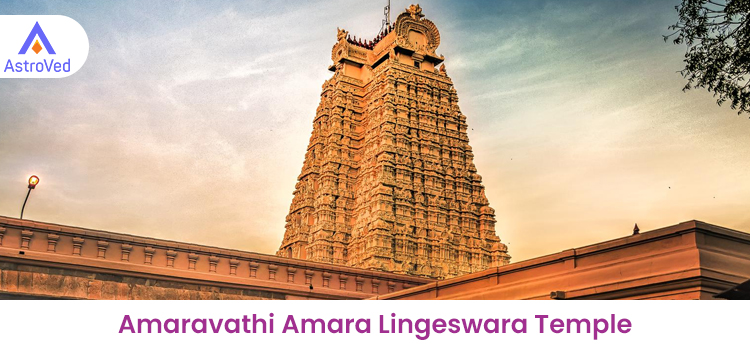Amaravathi Amara Lingeshwara Temple is dedicated to Lord Shiva, who is worshipped as Amareswara or Amaralingeswara here. Amareswara’s consort is Bala Chamundika.
The temple is one of the Pancharama Kshetras – 5 holy Hindu sites. It lies in the temple town of Amaravathi, Guntur district, Andhra Pradesh, on the southern banks of the Krishna River.
Amaravathi Amara Lingeswara Temple is one of the oldest and most renowned temples in India. Built a few centuries ago, the temple has a grand appearance and boasts intricate sculptures and architecture.
The Shivalinga here is quite tall (15 ft) and there is a red stain on it. Supposedly, a nail was driven into the top of the Linga as it kept getting bigger and bigger. When the nail pierced the Shivalinga, blood supposedly came out of it, creating the red stain.
Legend of the Temple
Once, Shiva and his Ganas were residing at Dhanyakataka. Shiva gave a boon to the demon king Tarakasura, who helped him conquer the gods. When the Devas began to live here after losing the war, the place came to be called Amaravati. The war between Lord Indra, the king of the gods, and Tarakasura raged for 10,000 years. After losing the war, Indra sought Vishnu’s help. Vishnu told Indra to worship Shiva, as it was Shiva who had given the boon to Tarakasura.
Shiva did not wish to kill Tarakasura, who was his great devotee. So, he made his son, Kumara Swamy (Muruga), the commander-in-chief of the gods. As he wore the Shiva Lingam around his neck, nobody could harm Tarakasura. Vishnu advised Kumara to use the Agni Astra to break the Shiva Lingam.
After Kumara Swamy killed Tarakasura, the Shiva Lingam on his neck broke into five parts, and then the parts began to rejoin. Indra, Surya (Sun god), Chandra Dev (Moon god), Vishnu, and Kumara Swamy built the Lingam with great devotion to prevent reunion. Along with Brihaspati, the Guru of the gods, Indra built the central piece, which he called Amareswara.
Shukrachrya, the Guru of the demons, asked Brihaspati how he could construct the Linga in this place, as the Krishna River was prone to floods the region. Brihaspati replied that the first piece had fallen on Krouncha Shaila’s peak, after which it traveled to Patala, where it began to develop. Even if the river flooded, it would not affect the area. Even today, the Krishna River flows from north to south in this area.
In the places where the Shiva Lingam broke into 5 parts and scattered, the 5 Pancharama Kshetras arose, according to mythology.
Some devotees also believe that Indra erected the Shiva Lingam in this temple.
Temple Architecture
Some claim that the temple was originally a Buddhist stupa. The temple’s base does have some Buddhist architectural features. The Mula Virat in the sanctum is a lotus medallion made of white marble, which is typical of Buddhist architecture.
The Amaravati Temple displays the Dravidian architectural style. The shrine has four Gopurams and a Vimana. There are 3 stories, which are laid out in the form of three concentric circles. The three stories have four pillars facing each of the four cardinal directions.
The first circle contains the temples of Mahishasura Mardini, Veerabhadraswamy, Omkareswara Swamy, Guru Dattatreya, and Agasteswara Swamy. The second circle contains the temples of Kalabhairava, Vinayaka, Anjaneya, Nagendraswamy, and Kumaraswamy, and a statue of Krishna beneath a tree. The third circle has temples of Kasi Viswanatha, Mallikarjuna, Pushpadanteswara Swamy, and Kalahasthiswara. The deity Amareswara is at the center of these three circles.
The Kota chiefs who ruled Amaravati left many inscriptions on the walls of the temple. The Vijayanagara emperor Krishnadevaraya also left inscriptions on them. The wife of Proli Nayudu, who was the minister to the Kota monarch, Ketaraja, engraved an inscription on the Mukhamandapa pillar. When the Gopuram of the temple developed cracks, Vasireddy Venkatadri Naidu rebuilt it. During this renovation, 1800-year-old relics were found in the foundation pits.
Shiva Lingam is the main deity here. Priests must climb a pedestal platform to reach the Shiva Lingam and perform the daily rituals.
Significance of Amaravathi Amara Lingeswara Temple
According to the Skanda Purana, at the end of Dwapara Yuga (around 5053 years ago) and the beginning of Kaliyuga, Sage Sounakadi questioned Sage Narada about the most effective way to attain Moksha. Narada’s advice was that Sage Sounakadi should bathe daily in the Krishna River and reside on its banks. According to Narada, Krishna had created the Krishna river so that saints could get salvation by bathing in it.
Narada then told Sage Sounakadi the story of the Amareswara temple and explained how Shiva manifested as a Lingam to fulfill his devotees’ wishes. He added that those who bathed in the Krishna River and worshipped Amareswara in this temple would become pure and sinless. Those who remained here for three days and worshipped Shiva with devotion would be able to reach Shiva Loka. Due to the significance of the location, the temple was built here, as those who die here will supposedly be absorbed by Shiva.
Festivals at the Temple
The temple’s major festivals include Mahashivaratri, which falls on Magha Bahula Dasami, Navratri, and Kalyanotsavam. Poojas, Abishekams, and other ceremonies are performed regularly for the deity. Amareswara Swamy is said to be a wish-fulfilling deity. Devotees also believe that worshipping at this temple can restore harmony in the family.
Temple Timings
Morning: 6.00 am – 1.00 pm
Evening: 4.00 pm – 8.00 pm
How to Reach
By Air
The nearest airport is in Vijayawada, located 56 kilometers away.
By Rail
The closest train station is Pedakurapadu, which is part of the Guntur Railway division. Guntur is well-connected to all regions.
By Road
The State Transport Corporation runs bus services to the temple from Guntur, Vijayawada, and Mangalagiri. Amaravati is 30 km away from Guntur’s central bus station. One can take a taxi or autorickshaw to the temple.


